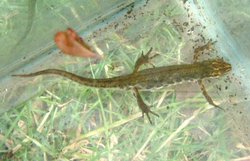Smooth Newt
|
|
| Smooth Newt | ||||||||||||||
|---|---|---|---|---|---|---|---|---|---|---|---|---|---|---|
 | ||||||||||||||
| Scientific classification | ||||||||||||||
| ||||||||||||||
| Binomial name | ||||||||||||||
| Triturus vulgaris (Linnaeus, 1758) | ||||||||||||||
| Subspecies | ||||||||||||||
|
T. vulgaris ampelensis |
The Smooth Newt (Triturus vulgaris) is the most common newt species of the Triturus genus. It is found throughout Europe except the far north and the Iberian peninsula. The smooth newt can grow up to 10 cm long. There is a difference between the male and the female: the male is brown with spots, and the female is plain brown. The male has a wavy crest along the back and tail, when in breeding condition. Newts have a tadpole stage- tadpoles look like adult newts, but have feathery gills on each side of their head.
Newts are protected from becoming endangered. In Europe there are laws prohibiting the killing, destruction, and the selling of newts.
Template:Reptile-stubda:Lille vandsalamander (Triturus vulgaris) de:Teichmolch nl:Kleine watersalamander pl:Traszka zwyczajna fi:Vesilisko sv:Mindre vattensalamander
